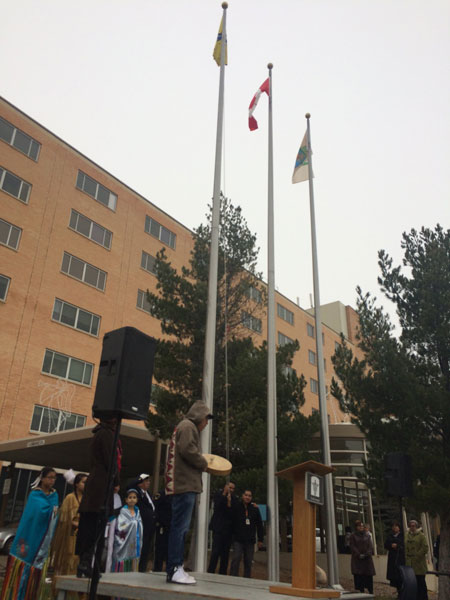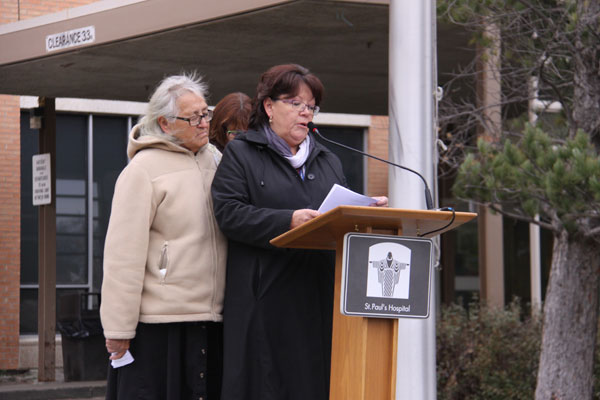Flag of Reconciliation raised at Saskatoon hospital
- Andréa Ledding | October 15, 2016
Despite the cold, more than 100 people gathered to witness the Saskatoon Health Region (SHR), led by Residential School survivors Neal and Gilbert Kewistep, raise a Reconciliation flag at St. Paul’s Hospital. Community partners included Central Urban Métis Federation (CUMFI) and Saskatoon Tribal Council (STC), represented by Shirley Isbister and Chief Felix Thomas.
SHR President Dan Florizone particularly thanked all who had suffered directly and indirectly from the residential schools for being present and leading the way.
“We’ve made some strides, but when we reflect back we have not as a health system done the best we can to serve First Nations and Métis people.” Florizone added that they wanted to make progress and actions, not just words. “Today we commit to reconciliation. Today we commit to, in the best way we can today, move forward...it’s a new day, it’s a new time, it’s a new commitment.”
“Treaties are between partners,” noted Thomas. “They came together to try and have a good way of life between the settler communities and the First Nations communities. Reconciliation came because of that broken partnership, and when we talk about reconciliation, as First Nations we’re not the only ones reconciling, a lot of times we’re the victims...there’s two parties in reconciliation, as there were two parties in the treaties.”
Related:
- Flag of Reconciliation raised in Saskatoon
- Thousands join Walk Your Roots reconciliation walk
- PHOTO GALLERY: Walk Your Roots reconciliation walk
- TRC releases final report in Ottawa
- Read the 94 recommendations made by the TRC
He pointed out that everyone benefits from the treaties, and the First Nations have fulfilled their part but not seen their promised benefits and reciprocity, so it is important to see reconciliation events and public acknowledgement to serve all communities with dignity and quality of life. He described the process as involving uncomfortable talks that have to happen, crediting Neal and Gilbert Kewistep with leading the way with this particular venture.
Neal Kewistep commended the survivors who started the conversation by speaking their truth, and their courage in coming forward. He spoke with pride of his father Gilbert, who taught him what happened, so that by the time Neal went to Lebret he was so scared from his father’s stories, he ran away after a week and never went back.
“I also want to thank our community for pushing us to make this commitment that we made today. Most importantly, this is about honouring the survivors and their families, for having the courage to speak their truth. Today doesn’t happen without their leadership.”
The flag was then passed around for everyone to touch and commit to in prayer. After veteran Edwin St. Pierre led silence and prayer for those taken, Neal and his father Gilbert raised the Reconciliation Flag while an honour song was drummed.
Related:
- Indigenous stories and the social determinants of health
- Historic MOU signed in response to TRC recommendations
Later, SHR employee Sharon Clarke spoke about the effects on herself, her own family, and the communities.
“Like many people, I am the third generation to attend residential schools: at best we were not whipped, not starved, not sexually or verbally abused. At worst we were abused, taught to hate ourselves and our people, taught fear and anger, and worst of all, learned to do what was done to us, to others.”
She added this comes out, even if repressed, in negative health outcomes. Many times institutions can replicate conditions, becoming triggers to survivors, while many survivors die young, an immense loss of potential which needs to be addressed.
“To start, we can utilize the TRC Calls to Action as a framework to move forward. We can create an Aboriginal model of care that includes attention to nutrition, Elder services, language, and addressing gaps in care. We can provide cultural competency education to staff that meets their needs, too.” Clarke added that a representational workforce would also help.



